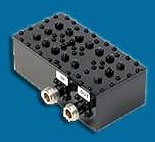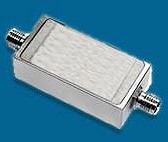Anatech Electronics Newsletter - October 2018 |


Press Release Archives: 2024 | 2023 | 2022 | 2021 |2020 2019 | 2018 | 2017 | 2016 | 2015 2014 | 2013 | 2012 | 2011 | 2010 2009 | 2008 | 2007 | 2006 | 2005 Content is copyright of company represented. Page format, custom text and images are RF Cafe copyright - do not distribute.
Anatech Electronics, a manufacturer of RF and microwave filters, has published its October newsletter. In it, Anatech founder and owner Sam Benzacar discusses the finally come-of-age Microelectromechanical systems (MEMS) switch for RF use. A MEMS switch is smaller and lighter than any other switch technology, has very little insertion loss, provides very high isolation, can theoretically operate into the millimeter-wave region, and can handle substantial amounts of RF power. RF MEMS switches' Achilles heel at the moment is relatively low isolation (~25 dB) compared to other types of RF switches. Sam also includes some relevant telecomm industry headline news. A Word from Sam Benzacar  The MEMS RF Switch is Ready By Sam Benzacar Microelectromechanical systems (MEMS) devices have been used for many years in as accelerometers and various other types of sensors, but even though the technology has huge benefits for RF switching, there have been few commercial devices, and only about three companies manufacture them today. The reason is that switches are different from other MEMS devices, and it has taken many years to develop them, produce them in large quantities and achieve high levels of reliability over billions of switching cycles. Unlike the many other functions for which MEMS devices have been commercialized for many years, RF switches present unique challenges and achieving wide bandwidths, high reliability, and commercial producibility in a tiny RF MEMS switch has been an elusive goal since the technology was first realized. However, after countless efforts by organizations ranging from DARPA to defense contractors, academia, private research organizations, and other entities, the path is now open for MEMS to deliver performance unachievable by any other technology. However, this has begun to change.
For RF and microwave applications, MEMS switches have the potential to be used for replacing coaxial switches in test equipment, switched filter banks, array antennas, general purpose RF and microwave multiplexing, and have demonstrated their ability to operate at up to 18 GHz with frequencies likely to increase in the future. Power handling ability of MEMS switches is currently about 150 W pulsed with isolation greater than 25 dB, and OIP3 of at least 85 dBm. A packaged six-channel MEMS switch measures only 5 x 5 x 1 mm in a QFN package, as well. In short, the MEMS switch has the potential to take the place of many other types of switches in various microwave applications. What's News...
Harris Corp. and L3 Technologies are merging in an all-stock merger of equals, making the combined entity L-3-Harris Technologies the sixth largest U.S. defense contractor, with 48,000 employees, $16 billion in annual revenues, and customers in more than 100 countries. The combined company will be headquartered in Melbourne, FL. The combined company is expected to generate earnings before interest and taxes of $2.4 billion and a cash flow of $1.9 billion.
Russia is reportedly testing microwave directed-energy weapons at firing ranges tested at firing ranges that are designed to burn missile-homing systems and may be incorporated in the arsenal of sixth-generation fighter jets. Directed-energy weapons can be used to disable incoming missiles by destroying their guidance systems. They will be integrated into the multifunction device including radar and other sensors as well as EW, missile-guidance, and possibly a communication system. Its offensive use would produce large amounts of microwave radiation, which would be harmful to pilots, meaning that only UAV-type aircraft would be suitable.
Vayyar Imaging as designed him millimeter-wave radar sensor that can create 3D imaging of the environment inside and around a car. Vayyar has previously created 3D radar sensors that can see through walls, making better stud finders for carpenters and even figuring out if someone in your house stops breathing. The devices can send out low-frequency radio waves that bounce off objects and Vayyar's sensors can detect these objects and build a 3D map of a space. It delivers the millimeter-wave 3D imaging capability on an SoC and would allow automakers to reduce the overall number of sensors. The system collects the reflections and analyzes them putting them back together as a 3D image in real time. The kit includes a 77 to 81 GHz ASIC featuring 48 transceivers that include DSP, an antenna and a USB interface.
Qualcomm as introduced 60-GHz Wi-Fi SoCs, the QCA64x8 and QCA64x1, that can deliver speeds of over 10 Gb/s with the 802.11ay standard designed to cover short ranges indoors rather than longer ranges as do other Wi-Fi standards such as 802.11ac. However, 802.11ay does cover up to 300 meters in some cases but cannot easily penetrate walls. 802.11ay can support sensing applications like presence detecting, gesture recognition, room mapping, precise location, and facial feature detection.
Check out Our Filter Products
Cavity Band Pass Filters LC Band Pass Filters Cavity Bandstop/Notch Filter About Anatech Electronics Anatech Electronics, Inc. (AEI) specializes in the design and manufacture of standard and custom RF and microwave filters and other passive components and subsystems employed in commercial, industrial, and aerospace and applications. Products are available from an operating frequency range of 10 kHz to 30 GHz and include cavity, ceramic, crystal, LC, and surface acoustic wave (SAW), as well as power combiners/dividers, duplexers and diplexers, directional couplers, terminations, attenuators, circulators, EMI filters, and lightning arrestors. The company's custom products and capabilities are available at www.anatechelectronics.com. Contact: Anatech Electronics, Inc. 70 Outwater Lane Garfield, NJ 07026 (973) 772-4242
Posted October 24, 2018 |
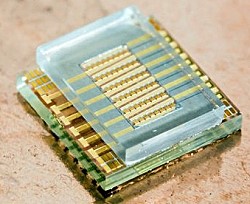 A
MEMS switch is smaller and lighter than any other switch technology, has very little
insertion loss, provides very high isolation, can theoretically operate into the millimeter-wave
region, and can handle substantial amounts of RF power. The first company to develop
and commercialize a MEMS switch was Analog Devices, which still makes them, and today
only Menlo Microsystems and Cavendish make them as well.
A
MEMS switch is smaller and lighter than any other switch technology, has very little
insertion loss, provides very high isolation, can theoretically operate into the millimeter-wave
region, and can handle substantial amounts of RF power. The first company to develop
and commercialize a MEMS switch was Analog Devices, which still makes them, and today
only Menlo Microsystems and Cavendish make them as well.  L-3 Merges with
Harris
L-3 Merges with
Harris 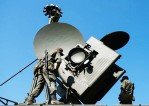 Russia Testing Microwave Weapons
Russia Testing Microwave Weapons 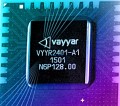 Vehicle Radar Goes
3D
Vehicle Radar Goes
3D  Qualcomm Releases 60-GHz Wi-Fi SoC
Qualcomm Releases 60-GHz Wi-Fi SoC